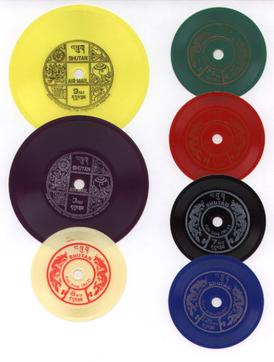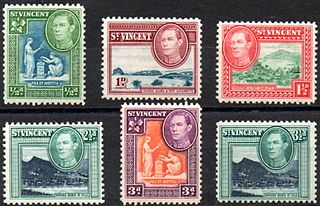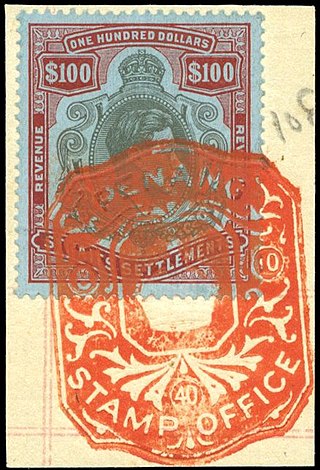The first omnibus issue
The first omnibus has been said to be the issue of 1898 by the Portuguese colonial empire to commemorate the quatercentenary of Vasco de Gama's discovery of the sea route to India. [1] [2]
In philately, an omnibus issue is an issue of stamps by several countries with a common subject and which may share a uniform design. Omnibus issues have often been made by countries under common political control or groups of colonies due to the close co-operation required to produce the issue. Omnibus issues are to be distinguished from joint issues which are usually much smaller in scope.
The first omnibus has been said to be the issue of 1898 by the Portuguese colonial empire to commemorate the quatercentenary of Vasco de Gama's discovery of the sea route to India. [1] [2]
Omnibuses have been particularly associated with stamps from the former British Empire, now the British Commonwealth, due to the large number of territories participating. Initially designs were identical for each colony with only the values, colours and colony names varying. Over time, however, a wider range of designs has been used within the same issue. The first issue was the Silver Jubilee issue of 1935. [3] Many others have followed, usually on themes related to the British Royal Family, but also for subjects such as Freedom from Hunger (1963) and the 1966 Football World Cup. Not every colony necessarily participates in every issue, although the revenue produced by the stamps is a valuable source of income for many smaller colonies/countries which may have few other ways of raising funds.
A list of British Omnibus issues is given below:
1935 - Silver Jubilee
1937 - Coronation
1945-1946 - Peace and Victory
1948-1949 - Silver Wedding
1949 - Universal Postal Union
1951 - University
1953 - QEII Coronation
1953 - Royal Visit
1958 - West Indies Federation
1963 - Freedom From Hunger
1963 - Red Cross Centenary
1964 - Shakespeare
1965 - International Telecommunication Union
1965 - International Cooperation
1966 - Churchill Memorial
1966 - Football World Cup
1966 - U.N.E.S.C.O Issue
1966 - World Health Organization
1966 - Royal Visit to the Caribbean
1972 - Royal Silver Wedding
1973 - Royal Wedding Princess Anne
1974 - Churchill Centenary
1977 - Royal Silver Jubilee
1978 - 25th Anniversary of Queen Elizabeth's Coronation
1980 - Queen Mothers 80th Birthday
1981 - Charles and Diana Royal Wedding
1982 - Princess Diana 21st and other Birthdays
1985 - Life and Times of Elizabeth the Queen Mother
1990 - Queen Mother's 90th Birthday
1997 - Queen Elizabeth Golden Wedding
1931 - Colonial Exposition
1937 - International Exposition in Paris
1938 - Pierre and Marie Curie
1939 - Rene Caillie
1939 - New York World's Fair
1939 - 150th Anniversary of the Revolution
1942 - Protection of the Infants
1942 - Colonial Education Fund
1944 - Marianne Red Cross
1945 - Felix Eboue
1946 - Victory Anniversary
1946 - Chad to the Rhine
1949 - UPU Anniversary
1950 - Tropical Medicine
1952 - Military Medals
1954 - Liberation Anniversary
The omnibus remains popular with countries whose philatelic marketing is handled by the Inter-Governmental Philatelic Corporation as it enables those countries to market their stamps into the lucrative United States and European thematic stamp market by featuring subjects popular in those countries. These issues have, however, been criticised for not being relevant to the culture of the participating countries, for instance stamps featuring Disney characters issued by poor African countries.
While most earlier omnibus issues were genuine attempts to help a group of countries celebrate an anniversary or event, the fact that these became popular with stamp collectors tempted issuing authorities to bring out more stamps than would have otherwise been thought necessary. These were often heavily marketed. [4]
Kenya, Uganda, Tanganyika (KUT) is the name on British postage stamps made for use in the British colonies of Kenya, Uganda, and Tanganyika. The stamps were circulated between 1935 and 1963 by the joint postal service of the three colonies, the East African Posts and Telecommunications Administration, reconstituted as part of the East African High Commission from 1948 to 1961, the East African Common Services Organization from 1961 to 1967, and the East African Community from 1967 to 1977. Even after independence, the new separate nations continued to use the KUT stamps, and they remained valid for postage until 1977.

Postage stamps and postal history of Great Britain surveys postal history from the United Kingdom and the postage stamps issued by that country and its various historical territories until the present day.

This is a survey of the postage stamps and postal history of the Falkland Islands.
This is a survey of the postage stamps and postal history of Bechuanaland Protectorate.
This is a survey of the postage stamps and postal history of Hong Kong.

The history of postage stamps and postal history of Malaysia, a state in Southeast Asia that occupies the south of the Malay Peninsula and Sarawak and Sabah in the north Borneo, includes the development of postal services in these periods:

The postage stamps and postal history of Papua New Guinea originated in the two colonial administrations on the eastern part of the island of New Guinea and continued until their eventual merger, followed by independence in 1975.

This is a survey of the postage stamps and postal history of Gibraltar.

The first postage stamps of Bhutan were issued in 1962, the same year that the first motorable road was opened. Before that there was a mail delivery system in place for official mail using mail runners, and between 1955 and 1962 revenue stamps were accepted as payment for internal mail. With the opening up of Bhutan in the early 1960s, a formal postal system was introduced.

Key type stamps are stamps of a uniform design that were widely used by colonial territories in the 19th and 20th centuries.

Saint Vincent and the Grenadines, a former British colony in the Windward Islands, has produced stamps since 8 May 1861. The stamps featured either the British monarch’s head on them or the ER monogram and crown until around 1970. The stamps were printed with just "St. Vincent" until 1992 when the stamps began to print the full country name, "St. Vincent and the Grenadines".
This is a survey of the postage stamps and postal history of Brunei.

Postage stamps and postal history of Singapore surveys postal history from Singapore and the postage stamps issued by that country and its various historical territories until the present day. Postal service in Singapore began with the delivery of stampless letters whose cost was borne by the receiving person, later encompassed pre-paid letters carried by private mail carriers and provisional post offices, and culminated in a system of universal prepayment that required all letters to bear nationally issued adhesive postage stamps. Singapore is an island country off maritime Southeast Asia, located between the Straits of Malacca and the South China Sea.

This is a survey of the postage stamps and postal history of Saint Helena.

This is a survey of the postage stamps and postal history of Sierra Leone.

Malaysia first issued revenue stamps as the Straits Settlements in 1863, and continues to do so to this day. Over the years, a number of entities in modern Malaysia have issued revenue stamps.

Jennifer M. Toombs was a notable British postage stamp designer.